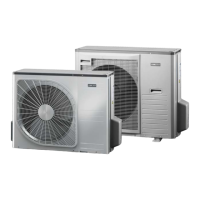If a leak is suspected, all naked flames shall
be removed/extinguished.
If a leak that requires brazing is detected,
all refrigerant must be removed from the
system and stored in a separate container.
Alternatively, the refrigerant can be stored
separated from the brazing area in a part
of the system at a safe distance from the
leak, if this part of the system can be dis-
connected safely with shut-off valves. The
system must be emptied in accordance
with the section “Removal and draining”.
REMOVAL AND DRAINING
When a cooling circuit is opened for repairs
– or for another reason– work must be car-
ried out in a conventional manner. Due to
the risk of fire it is important that best
practice is applied. Follow the procedure
below.
1.
Remove the refrigerant
2.
Open the circuit by cutting or brazing.
Collect the refrigerant in the intended cyl-
inders.
Ensure that the vacuum pump’s outlet is
not near to any potential ignition sources
and that there is satisfactory ventilation by
the outlet.
FILLING
In addition to the conventional filling pro-
cedures, the following actions must be
taken.
•
Ensure that different refrigerants are not
mixed when filling equipment is used.
Hoses and lines must be as short as pos-
sible to minimise the enclosed refrigerant
volume.
•
Containers must be stored in a suitable
position in accordance with the instruc-
tions.
•
Ensure that the cooling system is groun-
ded before the system is filled with refri-
gerant.
•
Mark the system once filling is complete
(if not already marked). If the amount dif-
fers from the pre-installed amount, the
marking must include the pre-installed
amount, the added extra amount and the
total amount.
•
Take extra care not to overfill the cooling
system.
Before refilling the system, pressure test it
with oxygen-free nitrogen. Leak test the
system after filling but before using the
system. Perform an additional leak test be-
fore leaving the installation.
DECOMMISSIONING
Before the device is taken out of operation,
the technician must without exception be
very familiar with the equipment and all its
component parts. Good practice prescribes
that all refrigerant is collected safely. Be-
fore the collected refrigerant can be reused,
oil and refrigerant samples must be taken,
if analysis is required. There must be a
power supply when this task is started.
1.
Familiarise yourself with the equipment
and its use.
2.
Isolate the system electrically.
3.
Before starting the procedure, ensure
that:
•
necessary equipment for mechanical
handling of the refrigerant container
is available
•
all necessary personal safety equip-
ment is available and used correctly
•
the collection process is continuously
supervised by an authorised person
•
the collection equipment and contain-
ers meet appropriate standards.
4.
Pump the refrigerant system to vacuum,
if possible.
5.
If it is not possible to pump to vacuum,
manufacture a branch, so that the refri-
gerant can be retrieved from different
parts of the system.
6.
Check that the refrigerant container is
on the scales before starting to collect.
7.
Start the collection device and collect
according to the manufacturer's instruc-
tions.
27AMS 20 | EN

